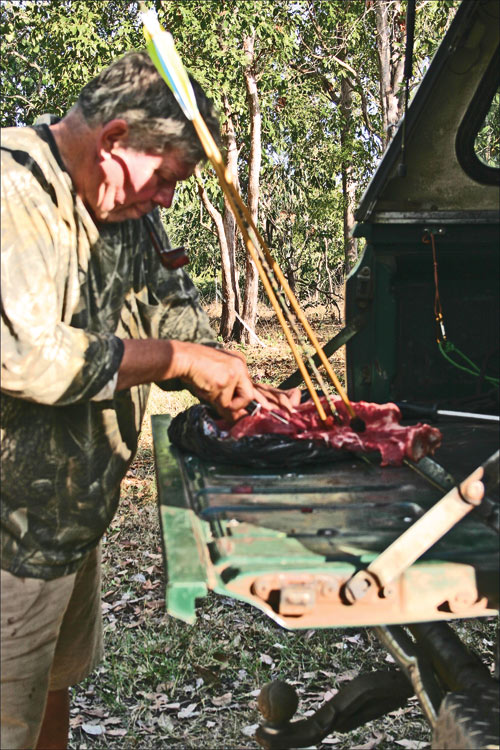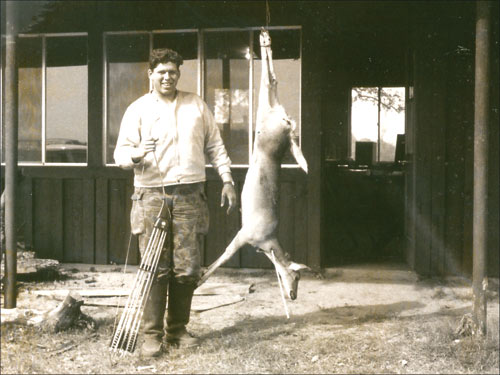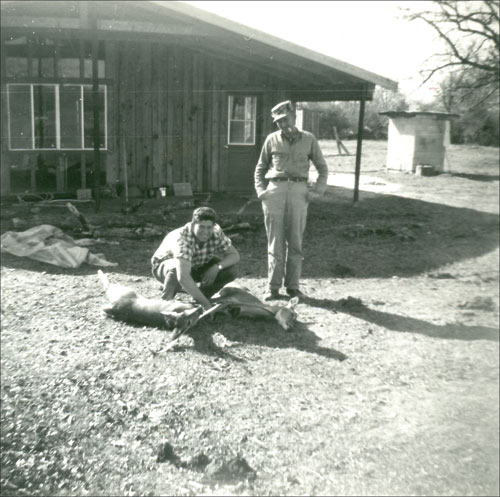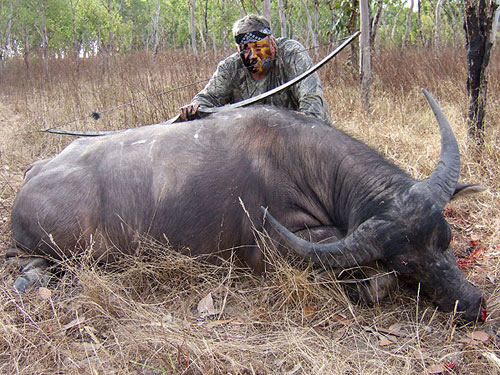By Dr. Ed Ashby – Re-published courtesy of Grizzly Stik
This second article in the series presents a synopsis of the data from the broadhead evaluation of the Natal Study and some of the associated information that surfaced during that study. It also examines arrow shot placement as a factor in lethality, and how broadhead selection impacts on the effectiveness of the various hits. The full report is too voluminous for presentation within the confines of limited space. The graphics presented in this article are drawn directly from the report and are numbered as in the original report. Some graphics, not directly related to this synopsis, have been omitted.
The project was conducted at Mkuzi Game Reserve in the Province of Natal, Republic of South Africa. Tony Tomkinson, then Chief Ranger at Mkuzi, was the moving force behind the research.
In the Natal Study, we set out to evaluate the effectiveness of as many types of broadheads as possible on a wide variety of game. The animals in the test included impala and bushbuck (average weight from 106 to 143 pounds), warthogs (154 – 220 pounds), Nyala (198 – 299 pounds), wildebeest (473 – 550 pounds), and the zebra (700 – 1000 pounds). Some testing was also conducted on giraffe and white rhino, but the data from these animals was not included in the performance analysis. The size of these animals places them outside the practical realm for all but the most experienced of archers.
All testing to evaluate broadhead performance was done with heavy draw weight bows. This was done to negate bow weight as a limiting factor. Tony used an 80# Martin Warthog compound for all his shooting, and I used a 94# Longbow. Thirty-two varieties of broadheads were tested. These included the most popular fixed and replaceable blade heads available at the time, and a number of limited production semi-custom heads.
The data was accumulated using two different sources. One was animals hunted and taken solely with a bow. This method was employed to the maximum extent possible. Where more detailed evaluation of a particular shot was desired, an animal was taken with a rifle (being careful not to damage any tissue even remotely near the site for the test shot) then positioned and shot with the arrow. These “simulated” test shots were taken immediately after the animal was put down. This minimizes the effects of tissue changes following death. Each shot was evaluated by wound channel examination and by dissection. All field evaluations were tape recorded and later transferred to written shot evaluation forms. All shot information was then transferred to a computer database program for analysis.
Where field evaluation was not complete enough, such as shots into the spine, the animal was returned to the slaughterhouse for full dissection and detailed shot evaluation. Shots taken on animals previously culled with a rifle were rated as lethal if: (1) a major nerve center was penetrated, (2) a major blood vessel was severed, (3) the thorax was penetrated and a vital organ hit, (4) a major visceral organ was hit, ie: kidney, liver, etc.
All usable meat from animals taken was salvaged. Non-usable parts were used in the predator feeding program at Mkuzi.
Detailed information from 154 consecutive shot records was included in the database for evaluation of broadhead performance. Some of the questions that we proposed to address were: (1) what are the most lethal shot angles; (2) what shot angles offer the least chance of a lethal hit; (3) which broadheads gives the greatest portion of lethal hits on the most difficult shot angles; (4) is there a significant difference in penetration among the types of heads and, if so, which penetrates best when soft (muscle, connective tissue, etc,) and hard (bone) tissue is hit; and (5) would a restriction on what types of heads could be used on what class of animal be appropriate.
Any analysis based upon such a limited number of test reports certainly is open to criticism, yet this study was, and still remains, the most extensive uniform methodology analysis of broadhead performance ever performed to date on actual game animals. The analysis was performed as uniformly and unbiasedly as possible. The results were so starkly clear that it is doubtful that a larger sample size would have altered the results to any significant degree.
One of the striking features noted during the testing was that a large number of the broadheads tested were extremely fragile, often bending or breaking whether the bone was hit or not. Table I and Graph I reflect the percentage, by type of head, damaged during testing. The rigid two-blade (or more accurately, single blade with two cutting edges) broadheads proved to be significantly more resistant to damage than either the rigid multi-blades or the replaceable blade type of broadheads.
Table II and Graph II are the results of the evaluation of the probability of a hit being lethal based solely upon the hit location (ignoring the type of broadhead used). Hits from directly in front, into the brisket, and shots from a forward quartering angle that hit back of the shoulder blade (to differentiate from shots taken into the very tough neck-shoulder junction area) were 100% lethal, but this was based upon a very limited number of shots. There were 25 shots quartering from the rear forward, with 24 of these being lethal hits (96%). It is of little surprise that this shot is generally regarded by experienced bowhunters as the very best. Not only does it position the hunter so that he may move freely to position for the shot, but also gives a great probability of a quickly lethal hit.
With indiscriminate broadhead selection, it was most disturbing that almost 30% of the broadside shots into the chest-shoulder area were non-lethal. All failures came as a result of inadequate penetration, generally due to broadhead failure. The broadside shot has long been considered the “classic” shot.
The rump hit proved fatal just over half the time. Its lethality proved dependent on (1) whether the femur is hit, (2) whether the broadhead could break the femur to reach the femoral artery and iliac vessels just deep of the femur, or (3) whether the hit is medial to the femur and penetration is deep enough to reach the vessels (significant penetration is required on a large animal such as a zebra).
As had been expected from past experiences, the toughest shot on which to make a kill was from a quartering angle into the area of the neck-shoulder junction.
Table III and Graphs III-VI reflect a further analysis of shots when single blade heads were compared to multi-blade heads. They address four scenarios: (1) the percent of hits that are lethal when single blade heads (disregarding any factors of broadhead quality) are compared to multi-blade heads, regardless of hit location; (2) when only shots that hit heavy shoulder blades are considered; (3) when a rib is hit on entrance; and (4) when the hit is in the area of the neck-shoulder junction.
Among the 16 scapulae (shoulder blade) hits with any single blade broadhead, 12 penetrated the scapula and rib cage to enter the thorax to be lethal hits. Four failed to reach the thorax: an Anderson 245 shot as a single blade (penetration was 3/8″ into the scapula); a Black Diamond which, according to the field notes “bent into a long curve” on impact with a zebra scapula; a Premium I which hit a warthog scapula and “bent at a 90 degree angle, arrow deflected, head destroyed”; and a Grizzly which penetrated the thickest part of a zebra scapula (through the scapular ridge) hitting a rib, but failed to enter the thorax sufficiently to be lethal.
Only three of the three blade heads hit a scapula: 2 Rocky Mountain Razors (one on a zebra, one on a wildebeest) and a Bodkin (zebra). None penetrated the scapula.
Among the 4, 5, and 6 blade heads, there were 8 hits on the scapula. Only two of these penetrated the bone; an Interceptor which penetrated a zebra scapula, and a Kolpin 6 used on a warthog. The Kolpin 6 achieved 10″ of penetration, but most of the blades (5 of 6) were sheared off and left in the scapula.
When a rib was hit on entrance, all hits with single blade heads were lethal (100%). The average wound channel was 19.1″ in depth (Table IV and Graph VII). There were ten shots in this group. Among three blade heads, only three shots hit ribs on entrance and only one of these, a Snuffer that chipped a rib on the entrance on a warthog, penetrated to be a lethal hit (33.3%). Penetration on this shot was 14″. The 2 non-lethal hits were both with 150 gr. Rocky Mountain Razors (one on a nyala, and one on a wildebeest). With the other multi-blade heads, 7 of 12 hits encountering a rib on entrance penetrated to be lethal (58.3%). Five failed to penetrate the rib.
The last section of Table III was the most striking result. If one considers only the most difficult of all shots, with the animal quartering toward the archer and the arrow striking in the area of the neck-shoulder junction, only 51.5% of all the hits were lethal (Table II). But when the type of broadhead enters the equation (Table III and Graph VI), the results are starkly revealing. When any single blade broadheads were used, 85% of the hits in the neck-shoulder junction were lethal (17 of 20 hits). None of the hits with multi-blade heads were lethal (zero of 16).
The three single blade heads that failed to penetrate on the neck-shoulder hits were a Howard Hill, a Black Diamond, and a Timberwolf. All three of these heads bent on impact with bone and failed to penetrate. The bulk of the lethal shots (8 of 17) with the single blade heads were on the animal we judged to have the heaviest bone structure of all the test animals, the wildebeest. The wildebeest also has an average skin thickness over the neck-shoulder area of 8mm. Most neck-shoulder junction shots with the multi-blade heads were taken on lighter built animals (all but 2 were on “light” animals, ie: warthogs, nyala, and impala).
Table IV and Graph VII reveal that when a bone of any type is hit, single blade heads offer vastly superior penetration. Even when only soft tissue is hit, single blade heads penetrate substantially better than the multi-blade heads. If the thorax is entered, the superior penetration of the single blade would be offset by the greater cutting area of the multi-blade heads. But, there is a significant reduction in the percentage of the shots reaching the lethal area with multi-blade heads.
The strongest point of the rigid single blade head is the vastly superior penetration. Nowhere was this more evident than when an analysis was completed on shots that hit the vertebral column. There were 12 hits in the vertebral column with single blade heads. Ten of these penetrating sufficiently to sever the spinal cord (83.3%). Of these ten hits, six penetrated the scapula before hitting the spine! One hit penetrated a rib before hitting the spine. Nine multi-blade heads hit the spine. None penetrated enough to reach the spinal cord.
Comments, Observations, Opinions
A number of items were observed as our testing progressed. Some of these we had not kept track of sufficiently to analyze fully, and some could not be quantified.
Since we had planned to test a large quantity of broadheads, most heads with tapered ferrules had been mounted on the “screw-in” type broadhead adapters. Most replaceable blade heads have this screw-in type mounting system integral with the broadhead. This appears to be a significant weak link in the arrow/broadhead system. A large number of the adapters bent on both soft and hard tissue hits. It would be advantageous to use a fixed broadhead taper mounting system, especially for medium and large animals.
Additional testing was done with various arrow shaft materials. During analysis, it was determined that there was not sufficient data with the other variables remaining constant for definitive (statistically significant) conclusions to be drawn. Some inferences were, however, suggested by the results. Various shaft materials appear to penetrate equally when all other factors are equal.
Shaft durability, especially when very heavy bone was impacted, was a factor of initial concern. We tested shafts of aluminum (Gamegetter and XX75), fiberglass, graphite, cedar, compressed cedar and a composite shaft of graphite with a compressed wood inner shaft. All were relatively more damage resistant to heavy impact than had been expected. Most frequently damaged were fiberglass and aluminum, followed very closely by the graphite and cedar shafts. Neither the compressed wood nor the composite shafts suffered any shaft damage from impact during testing.
Data was suggestive that shaft diameter did appear to be of significance in penetration. When velocity, broadhead and arrow mass were constant, shafts (1) smaller than the broadhead ferrule in diameter, (2) equal to the broadhead ferrule in diameter and (3) larger than the broadhead ferrule diameter did appear to be a significant factor in penetration. No difference was discernible between shafts of varying amounts smaller than the broadhead’s ferrule. If the smaller diameter shafts are assigned a factor of 1.0, then the apparent reduction in penetration was 10 percent (0.9) for shafts equaling the broadhead’s ferrule diameter and 40 percent (0.6) for shafts of diameter exceeding than the broadhead’s ferrule.
Measured penetration on shots striking similar tissues was suggestive that there is a definite lower limit to arrow mass, regardless of shaft material, for adequate penetration, even when the best of the broadheads were used. Consistently reliably adequate penetration appeared to require a total arrow mass of at least of 650 grains if any bones were encountered on the animals of moderate size. There also appears to be a marked increase in penetration occurring when the total mass was in the 900-grain range or heavier. These “super heavy” arrows would appear to be the obvious choice for really heavy animals.
It has long been claimed that multi-blade broadheads leave a better blood trail than single blade heads. There appears to be no way to quantify this factor in a field situation. From observations, it appears that the degree of blood trail is solely dependent on (1) where the animal is hit and (2) is there an exit wound.
In this testing, there were 77 shots with single blade heads and 77 shots with multi-blade heads. With roughly equal hit locations and the absence of an exit wound, I was unable to distinguish any difference in the quantity and quality of the blood trail left by hits with single and multi-blade heads. With an exit wound, the blood trail is greatly increased, especially when the shot is taken at a downward angle, such as from a tree stand.
Single blade heads achieved total penetration (exit wound) on 22.1% of the hits. Multi-blade heads had total penetration on only 10.4% of the hits. Single blade heads were more than twice as likely to leave an exit wound (Graph IX). They were also able to immobilize the animal over 80% of the time when the spine was hit (as opposed for zero percent for multi-blades) (Graph X). The claims of increased trailing ease with the use of multi-blade heads appear ill-founded.
Based on the test results, no responsible bowhunter using a multi-blade head should take a shot at even a modest sized animal that is facing him or angling toward him. The chance of a hit into the non-lethal neck-shoulder area is too great. Conversely, with a heavy draw weight bow, a strong single blade broadhead, and good arrow mass, this becomes an effective shot even on relatively large animals.
How did the specific broadheads compare? Four broadheads tied for the title of “Worst Performance”. Each head was totally destroyed on each shot – several of which did not hit any bones. They were: the Kolpin 6, Razorbak 5, Bear stainless steel Super Razorhead (conversely, the old carbon steel Razorhead performed fairly well), and the Viper (which was a failure in all categories). Almost every Magnum II 4-blade broadhead shattered on impact, even with soft tissue. It is suspected that this was the result of faulty tempering of the steel (too brittle). No such problem was encountered with the Magnum I, which is identical except for the shape of the trailing edge. The Premium I broadhead failed in every instance where a bone was encountered but performed well in soft tissue.
All replaceable blade broadheads proved very fragile and generally gave inadequate penetration, particularly when any bone was encountered. The best performer of this group was the Muzzy.
Among rigid multi-blade broadheads, those offering the best performance were the Catclaw and the Interceptor. In our testing, the Martin Brute was used only as a single blade head, but it also accepts the Bear type bleeder blade insert and may well be a good choice as a multi-blade broadhead for moderate sized animals.
Once one leaves the light antelope class of animals a tough single blade is clearly the choice. Most of the tougher single blade heads performed well, but most also occasionally failed when heavy bone was encountered at an oblique angle. The Howard Hill and Black Diamond (both of which had long been favorites of mine for large animals) demonstrated a disturbing tendency to bend on this type of hit, as did the Timberwolf and the Martin Brute.
Three broadheads took all we could throw at them and finished all the test undamaged. Each gave outstanding performance. All were fairly heavy, rigid, single blade broadheads. These were the “Best of the Best”. One was the old Ben Pearson Deadhead. It performed flawlessly but, sadly, it is no longer in production. A second excellent performer was the Maxi-Head. A semi-custom head, it features a long, slightly concave, cutting edge with serration. My own personal choice for the award of the best broadhead tested is the Grizzly.
The Grizzly is a large, long, extremely tough broadhead. It has a length three times its width. This broadhead was available in two hardnesses, Rockwell 44 and 55, and in several weights. Only the heaviest, at 190 grains, was tested. Only one shot was taken with the “softer” (44 hardness) head, and the tip was slightly flattened after penetrating a wildebeest shoulder blade on a neck-shoulder junction shot. Penetration was 12 inches.
Only one non-lethal shot was recorded with the Grizzly head. This was with a light arrow (554 grains) on a large (approximately 1000 lb.) zebra stallion. To quote the field notes, this shot went “through the thickest part of the scapula (1″ of bone), into a rib, did not reach into the thorax…”.
The 55 hardness Grizzly was not damaged on any of the shots. And many were exceedingly hard hits, for example: “zebra, through scapula, into spine, cut spinal cord, head penetrated 3″ into spine…”; “nyala, through scapula into spine, cut spinal cord…”; wildebeest, neck-shoulder shot, “through scapula, through thorax, cut rib on opposite side…”; “bushbuck, hit right gut, cut left femur below ball joint, exited left hip…”.
Progressively more difficult shots were taken with the Grizzly broadhead in an attempt to find the limits of its performance. It recorded a remarkable 95.8% lethal hits on the toughest shots that we could devise. It was 100% lethal on those tough neck-shoulder shots (and 75% of those neck-shoulder shots were on the toughest animal tested, the wildebeest).
Remarks
One of the goals of our testing was to determine recommendations on what type of broadhead should be used on what class of animal. My recommendations are that, even with careful shot selection, multi-blade heads should not be used on animals larger than nyala (large mule deer size game). Certainly, larger animals can be taken cleanly with multi-blade broadheads when everything goes perfect, but as long as the very fastest arrows travel not much over 250 fps, and most less than 200 fps and animals move faster than the arrow, no archer can guarantee exactly where his shot will hit. We owe it to the animals we hunt to use equipment capable of making a clean kill when things don’t go just as we planned. That means a combination which includes a bow of adequate weight, an arrow of heavy mass, and a tough, rigid, well sharpened, single blade broadhead.
Part III of this series will deal with the historical development of much of the equipment in use today, and why ‘progress’ does not always produce superior results.
TABLE I: BROADHEADS DAMAGED OR DESTROYED BY SHOT
——————————————————————-
Rigid single blade broadheads 15.5%
Rigid multi-blade broadheads 50.0%
Replacement blade type broadheads 64.0%
TABLE II: PERCENT LETHAL HITS BY SHOT ANGLE (ALL BROADHEADS) ——————————————————————-
Quartering from the front (hits back of shoulder blade)100.0%
Frontal hits 100.0%
Quartering from rear 96.0%
Broadside 71.8%
Rear (rump) 54.5%
Area of neck-shoulder junction 51.5%
TABLE III: PERCENT LETHAL BY TYPE OF SHOT AND TYPE OF BROADHEAD
——————————————————————-
Broadside, single blade broadheads 81.8%
Broadside, multi-blade broadheads 64.9%
Broadside, single blade broadheads, scapula hit 75.0%
Broadside, three blade broadheads, scapula hit0.0%
Broadside, 4, 5, & 6 blade broadheads, scapula hit 25.0%
Single blade broadheads, rib hit on entrance 100.0%
Three blade broadheads, rib hit on entrance 33.3%
Other multi-blade broadheads, rib hit on entrance 58.3%
Single blade broadheads, hit in neck-shoulder junction 85.0%
Multi-blade broadheads, hit in neck-shoulder junction 0.0%
TABLE IV: AVERAGE PENETRATION BY TYPE OF SHOT AND TYPE OF BROADHEAD
——————————————————————
Scapula hit, single blade broadheads 8.5″
Scapula hit, three blade broadheads 3.0″
Scapula hit, four blade broadheads 4.1″
Rib hit on entrance, single blade broadheads * 19.1″
Rib hit on entrance, three blade broadheads 8.3″
Rib hit on entrance, four blade broadheads 11.9″
All soft tissue hit, single blade broadheads * 24.9″
All soft tissue hit, three blade broadheads 20.5″
All soft tissue hit, 4, 5, & 6 blade broadheads 16.6″
* Penetration by measured depth of wound channel. Many rib and soft tissue only hits with single blade heads had complete penetration. Actual penetration would exceed measured wound channel.
BROADHEADS TESTED:
——————————————————————
1. MUZZY
2. ANDERSON 245
3. HOWARD HILL
4. PREMIUM I & 2
5. BLACK DIAMOND (ESKIMO)
6. BEAR SUPER STAINLESS STEEL
7. (OLD) BEAR RAZORHEAD
8. ALASKAN
9. BRUTE
10. KOLPIN 6
11. CATCLAW
12. INTERCEPTOR
13. ROCKY MT. RAZOR (3 BLADE – 2 VERSIONS)
14. ROCKY MT. SUPREME (4 BLADE)
15. BLACK COPPERHEAD
16. RIPPER (BLACK COPPERHEAD SERRATED)
17. GRIZZLY
18. BODKIN
19. MAGNUM I
20. SNUFFER
21. BEN PEARSON DEADHEAD
22. TIMBERWOLF
23. VIPER
24. SATELLITE
25. WASP
26. MAXI-HEAD
27. RAZORBACK
28. THUNDERHEAD (2 VERSIONS)
29. WASP
30. REDD HEAD
31. MA-3
32. MAGNUM II
Copyright 1996, Ed Ashby
Copyright 1996 Dr. W.E (Ed) Ashby





